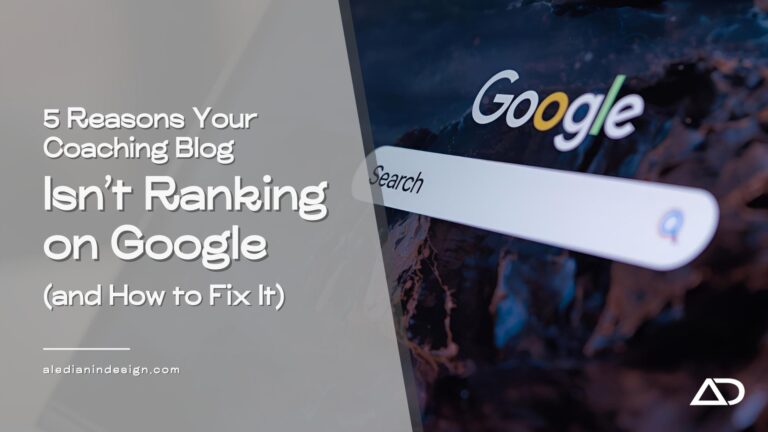
5 Reasons Your Coaching Blog Isn’t Ranking on Google (and How to Fix It)
If your coaching blog isn’t ranking on Google, you’re not alone. So many brilliant coaches pour time into thoughtful posts, but see little search traffic or client enquiries.
The good news? It’s not because blogging doesn’t work. It’s because Google needs clearer signals to know what your blog is about and who it’s for. Let’s break down the five most common reasons your coaching blog isn’t showing up, and what you can do to fix them.
If you missed my earlier piece on beating “random posts vs. paralysis”, you can catch up here: Blogging for Coaches: How to Stop Overthinking and Start Getting Found.
Why Your Coaching Blog Isn’t Ranking on Google
1. You’re Not Writing for Real Search Intent
Google rewards posts that answer specific questions. If your blog is only about broad concepts like The Power of Mindset, it might inspire, but it won’t match what people are actually typing into search.
Bad example: Blog title: The Power of Mindset, too broad, unclear intent, low search volume
Good example: Blog title: How to Rebuild Confidence After Job Loss: 7 Steps That Actually Work, clear query, real search volume, strong intent
Action steps:
Use Google Autocomplete → type “how to” + your niche
Check People Also Ask for question-based ideas
Look at AnswerThePublic for content gaps
Mine your client sessions, the FAQs you answer daily are golden
Takeaway: When you write for the exact queries your audience is searching, your coaching blog starts becoming visible on Google.
2. Your On-Page Structure Isn’t Helping Google
Think of Google like a librarian. If your blog is a pile of loose notes with no labels, it can’t index or recommend your content. On-page structure gives Google and your readers the clarity they need.
Essential SEO elements:
- Headings (H2s & H3s): Break posts into scannable sections with natural keywords.
- Internal links: Connect posts to each other and to your services to build authority.
- Meta title & description: Always add these, they tell Google (and readers) what your blog is about.
- Descriptive alt text: Add alt text with your focus keyword to images.
Takeaway: Structure your blog so Google understands what’s important; otherwise, even your best ideas won’t rank.
3. Your Posts Don’t Lead Anywhere
A blog that teaches but doesn’t guide becomes a dead end. Every post should give readers a clear next step that matches their intent and connects to your coaching services.
Strategic linking by content type:
Awareness posts, link to a free resource or lead magnet
Consideration posts, link to a service page or case study
Decision posts, invite readers to book a discovery call
Takeaway: When you link posts to your services, your coaching blog not only ranks better on Google but also converts readers into clients.
→ Ready to map your content to your services? Book a strategy call to discuss your specific situation.
4. There’s Not Enough Internal Linking
Google sees your site as a web. If posts aren’t linked together, it can’t understand your coaching expertise fully. Internal links help search engines map your authority and keep readers engaged longer.
Topic cluster example for confidence coaches:
Pillar page: “Complete Guide to Building Confidence”
↓
Supporting posts:
“How to Overcome Imposter Syndrome” ← links back to pillar
“Body Language Tips for Confidence” ← links back to pillar
“Confidence Building Exercises” ← links back to pillar
“Dealing with Self-Doubt” ← links back to pillar
Internal linking best practices:
Create topic clusters, link related blogs (e.g. imposter syndrome → confidence → leadership)
Always link to services, make sure each blog points to the relevant coaching package
Reduce dead ends, never let a blog stand alone, link at least two ways
Use descriptive anchor text, instead of “click here” use “confidence coaching services”
Takeaway: Strong internal linking shows Google your coaching blog deserves to rank for more than one post, it builds your authority over time.
5. Publishing Is Sporadic
Google values consistency. A burst of posts followed by months of silence doesn’t build trust or authority. You don’t need to publish weekly, but you do need a rhythm.
Sustainable publishing strategy:
Set a monthly cadence, one good post per month is enough to start
Repurpose smartly, turn each blog into a newsletter and 2 LinkedIn posts
Stay consistent, build a system you can sustain, not a sprint you’ll abandon
Batch content creation, write 3 months of content in focused sessions
Takeaway: Regular, optimised posts signal to Google that your coaching blog is active and trustworthy, a key factor in ranking.
Timeline: When to Expect Results
Month 1–2: Focus on optimization and consistency
Traffic may dip initially as Google reassesses your site
Implement technical SEO fixes
Establish publishing rhythm
Month 3–4: Early improvements appear
Some long-tail keywords start ranking
Existing content begins climbing search results
Internal authority builds through linking
Month 6+: Significant growth phase
Broader keywords start ranking
Organic traffic increases noticeably
Coaching inquiries from blog content begin
Reminder: SEO is a marathon, not a sprint. Coaches who stick with it see the best results.
Common Objections Addressed
“But I’m Not a Writer”
You don’t need to be Shakespeare. Your clients need your expertise, not perfect prose.
Write how you speak, imagine explaining this to a client over coffee
Use simple language, clarity beats cleverness every time
Focus on helping, when you genuinely want to help, the words flow naturally
Edit ruthlessly, good writing is rewriting, even professional writers edit multiple times
“SEO Feels Too Technical”SEO for coaches doesn’t require coding skills. Focus on these basics:
Choose one keyword per post and use it naturally
Write helpful content that answers real questions
Link to your other posts and services where relevant
Use headers to break up your content
Great content with basic SEO beats perfect technical SEO with poor content.
“I Don’t Have Time for All This”Start small:
Week 1, choose 5 keywords your clients actually search
Week 2, write one blog post answering one specific question
Week 3, add internal links to 3 existing posts
Week 4, set up a simple content calendar
One optimised post per month is better than 10 posts with no SEO.
Troubleshooting Guide
If you’ve tried everything and still aren’t ranking, check these common issues:
Technical problems:
Site speed, slow sites don’t rank, use Google PageSpeed Insights
Mobile responsiveness, 60% of searches happen on mobile
Indexing issues, check Google Search Console for crawl errors
Content problems:
Keyword difficulty too high, target easier, long-tail keywords first
Search intent mismatch, make sure your content matches what searchers want
Thin content, posts under 800 words rarely rank well
Competition analysis:
Research top-ranking pages, what are they doing that you’re not?
Find content gaps, what questions aren’t being answered well?
Local vs national, consider targeting “[your city] life coach” first
Authority issues:
New domain, new sites take 6–12 months to build authority
Lack of backlinks, focus on creating shareable, linkable content
Industry competition, coaching is competitive, patience and consistency win
Quick SEO Checklist for Coaches
Before You Write
- Choose one clear focus keyword, long-tail, with search volume but not too broad
- Plan the post’s purpose; is it to educate, nurture, or convert?
While You Write
1.Use the focus keyword naturally:
In the SEO title, close to the start
In the URL slug, short, readable, keyword-rich
In the first 100 words of the intro
In at least one H2 or H3
Sprinkled naturally 4–6 times in the body
2. Add supporting keywords, variations and synonyms to help Google understand the topic
3. Structure for readability, break with headings, bullet points, and short paragraphs
4. Include at least one strong CTA, book a call, download a resource, or visit a service page
After You Write (Optimisation Pass)
- Craft a compelling meta description (150–160 characters), include the keyword and make it sound like a promise
- Optimise images, descriptive filenames and keyword-rich alt text
- Build internal links, at least 2 blog posts, update old posts to link back, and add one external trusted link
Your Next Steps
If your coaching blog isn’t ranking on Google, it’s not because blogging doesn’t work for coaches; it’s probably because the SEO structure behind it is missing.
By aligning your topics with what clients actually search, structuring posts for both readers and search engines, and linking them strategically to your coaching services, you can turn your blog from a hidden diary into a powerful client attraction tool.
Try this right now: Open Google, type “how to” + your niche, and let autocomplete inspire your next blog post.
Download My Free SEO Checklist
Get my complete Coach’s SEO Checklist, a simple PDF that walks you through optimising every blog post for both Google and your ideal clients.
Ready for a complete blog strategy? In October, I’ll be sharing my brand-new Blog Content Strategy Package, designed to give you 12 months of blog ideas mapped to your offers, with a strategy for internal linking. No guesswork, just clarity.
→ Want help mapping out a blog strategy that actually works? Book a free strategy call with me here.
Pin this guide for later and share it with other coaches who are struggling with their blog SEO!
🎁 Ready to Make This Even Easier?
Grab my free AI Efficiency Quickstart Planner for Solopreneurs
It’s a short, step-by-step guide to help you:
Identify your biggest time drain
Choose the right AI tool for your business
Create one weekly workflow you can stick to
Save 5–10 hours a week with less stress
👉 Download the free planner here
Or want help mapping this to your own systems?
📞 Book a free 20-minute strategy call with me here
5 Reasons Your Coaching Blog Isn’t Ranking on Google (and How to Fix It) If your coaching blog isn’t ranking on Google, you’re not alone. So many brilliant coaches pour time into thoughtful posts, but see little search traffic or…
Blogging for Coaches: How to Stop Overthinking and Start Getting Found You stare at the blinking cursor, wondering if anyone’s even going to read this blog post… Sound familiar? If you’re a coach, nutritionist, or solopreneur, chances are you’ve had…

